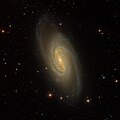NGC 2903
| Galaxy NGC 2903 |
|
|---|---|

|
|
| Image taken with the 81 cm reflecting telescope of the Mount Lemmon Observatory . | |
| AladinLite | |
| Constellation | lion |
|
Position equinox : J2000.0 , epoch : J2000.0 |
|
| Right ascension | 09 h 32 m 10.1 s |
| declination | + 21 ° 30 ′ 03 ″ |
| Appearance | |
| Morphological type | SAB (rs) bc I-II / HII |
| Brightness (visual) | 8.8 likes |
| Brightness (B-band) | 9.6 likes |
| Angular expansion | 12.6 ′ × 6 ′ |
| Position angle | 17 ° |
| Surface brightness | 13.3 mag / arcmin² |
| Physical data | |
| Redshift | 0.001834 ± 0.000001 |
| Radial velocity | (550 ± 0) km / s |
|
Stroke distance v rad / H 0 |
(21 ± 1) x 10 6 ly (6.43 ± 0.45) Mpc |
| diameter | 80,000 ly |
| history | |
| discovery | Wilhelm Herschel |
| Discovery date | November 16, 1784 |
| Catalog names | |
| NGC 2903 • NGC 2905 • UGC 5079 • PGC 27077 • CGCG 122-014 • MCG + 04-23-009 • IRAS 09293 + 2143 • 2MASX J09321011 + 2130029 • GC 1861 • H I 56 • h 604 • Kara 347 • HIPASS J0932 +21 | |
NGC 2903 is a barred spiral galaxy of the Hubble type SBbc in the constellation Leo at the ecliptic . The galaxy is around 21 million light years away from the Milky Way and is 80,000 light years across.
The object was discovered on November 16, 1784 by the German-British astronomer Wilhelm Herschel . The catalog entry NGC 2905 goes back to a light area in NGC 2903.
Detail of the Hubble Space Telescope
Image of the Hubble space telescope with line filter
Ultraviolet image of NGC 2903 using GALEX
Web links
- SIMBAD Astronomical Database
- Barred Spiral Galaxy NGC 2903 - Astronomy Picture of the Day of March 21, 2001.
- astronews.com: Bar-spiral galaxy details February 28, 2001
- astronews.com: Picture of the day March 21, 2013
- Spektrum.de : Amateur recordings [1] [2] [3] [4] [5]




